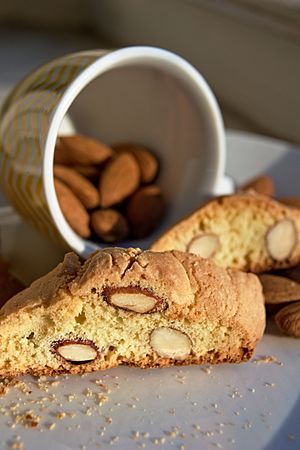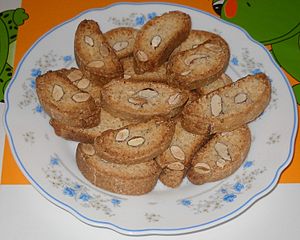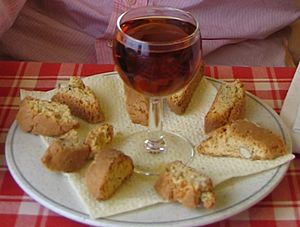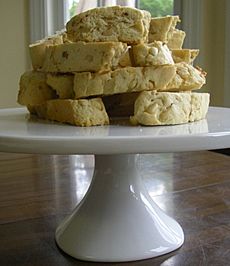Biscotti facts for kids

A traditional Tuscan cantuccio (biscotto).
|
|
| Alternative names | Biscotti di Prato |
|---|---|
| Type | Biscuit |
| Place of origin | Italy |
| Region or state | Tuscany, the town of Prato in particular |
| Main ingredients | Flour, sugar, eggs and almonds or pine nuts |
Biscotti (say "bis-COT-tee") are yummy Italian almond cookies. They are also known as cantucci (say "kan-TOO-chee"). These crunchy treats come from the city of Prato in Tuscany, Italy.
What makes them special? They are baked twice! This makes them super dry and crunchy. People often dip them in a drink, like the traditional Italian wine called Vin Santo, or even coffee or tea.
Contents
What's in a Name?
The Meaning of Cantuccio
The word cantuccio is an old Italian word. It means "little place" or "corner." In the past, it also meant a small piece of bread with lots of crust. Think of the end pieces of a loaf of bread – those "corners."
The Meaning of Biscotto
The word biscotto is used in modern Italian for any type of cookie or biscuit. It comes from a Latin word, biscoctus, which means "twice-cooked."
This name makes sense because biscotti are baked two times. Baking them twice makes them very dry. This helped them last a long time, which was great for travelers and soldiers in ancient times. The Roman legions, for example, ate a lot of twice-baked breads.
In English, the word "biscuit" also comes from this same idea. In British English, "biscuit" means what Americans call a "cookie." But when people outside Italy say "biscotti," they usually mean only this specific Italian cookie.
A Look at Biscotti History
Biscotti in Italy
While "biscotti di Prato" is the common name, these cookies are also widely known as "cantuccini" in Italy and Argentina. These names can sometimes be confusing because there are other similar cookies in different parts of Italy.
The name "cantuccini" is most common in Tuscany today. However, it originally referred to versions that were a bit different from the traditional recipe. These might have used things like yeast or other ingredients to make them less dry.
The famous "Biscottificio Antonio Mattei" in Prato, a leading cookie maker, has an old sign that says "Manufacturers of cantuccini." This sign has been there for so long that many people now connect the name "cantuccini" with the typical cookies from Sardinia and Sicily.
Biscotti Across Europe

The French word bescoit became "biscuit" in English. But remember, in English, "biscuit" doesn't always mean "twice-baked."
In France, a similar cookie is called croquant.
In Spain and France, there's a cookie called carquinyoli (say "kar-kin-YOH-lee"). It's made with whole or sliced almonds. You can find it in many places where Catalan is spoken. In some towns in Catalonia, they are also called carquinyols.
Biscotti are also traditional in some towns in Valencia, Spain. There, they are called rosegons or rosegós. On the island of Minorca, carquinyols are square-shaped and don't have whole almonds. Some food writers say carquinyoli comes from the French word croquignole.
Biscotti in North America
In North America, the word "biscuit" means something different (like a soft, savory bread). So, any twice-baked cookies are usually called "biscotti."
How Biscotti Are Made
The traditional recipe for biscotti was rediscovered in the 1800s by a pastry chef from Prato named Antonio Mattei. He even won a special award for his cookies at a big exhibition in Paris in 1867!
Traditional Recipe
The classic biscotti recipe uses only a few simple ingredients:
The traditional recipe does not use any yeast or fat, like butter or oil. The dough is not very wet. It's baked twice:
- First, the dough is shaped into a flat loaf and baked.
- After cooling, the loaf is sliced into individual cookies.
- Then, the slices are baked again. This second baking is what makes them so hard and crunchy.
In Italy, traditional biscotti di Prato are often sold with another sweet treat called bruttiboni. People usually eat them after dinner, sometimes with orange juice.
Modern Variations
Today, you can find many different versions of biscotti. Modern recipes often add other ingredients to the traditional ones.
Popular additions include:
- Different nuts: Besides almonds and pine nuts, you might find pistachios or hazelnuts.
- Spices: Like anise or cinnamon.
- Baking powder: This can make them a bit less dry.
- Flavorings: Such as almond extract or different liquors.
After the two bakings, some modern biscotti are even dipped in a glaze, like chocolate.
How to Enjoy Biscotti

Because biscotti are very dry and crunchy, they are usually served with a drink. You can dunk them in the drink to soften them up a bit.
In Italy, people traditionally enjoy biscotti as a dessert after dinner. They often dip them in a sweet, fortified wine from Tuscany called Vin Santo.
Outside of Italy, biscotti are more commonly served with coffee, like cappuccinos or lattes, or with black tea.
In Catalonia, Spain, carquinyolis are often served with a small glass of sweet dessert wine, such as muscat.
Biscotti in Culture
In the Catalan city of Vic, "Carquinyoli" is also the name of a special character. This character helps organize a summer festival each year to honor the city's patron saint, Albert of Sicily.
In Vilanova i la Geltrú, another Catalan city, biscotti with almonds are called currutacos. They are especially popular on Palm Sunday. People use them to decorate the palm leaves that are given out during church services.
Biscotti are not just for dipping! They are also used as an ingredient in many traditional dishes. In Catalonia, for example, they are used in dishes like rice with sardines and rabbit with snails. They can also be found in sauces, especially with onions called calçots. In a coastal area called Baix Llobregat, biscotti are even used in the sauce for a dish of duck stuffed with turnips!
See also
 In Spanish: Cantuccini para niños
In Spanish: Cantuccini para niños




